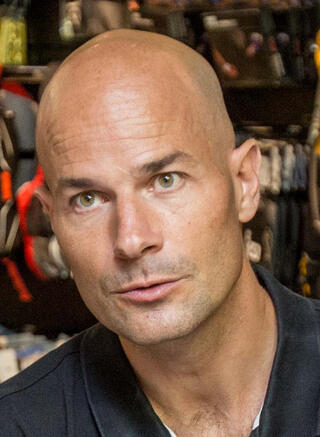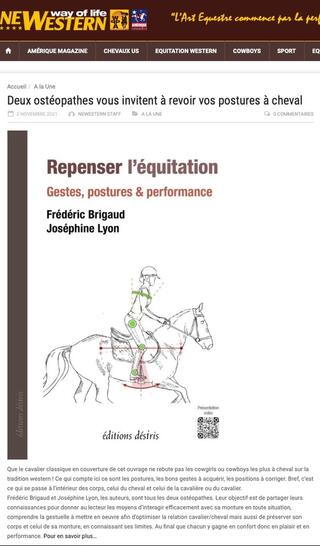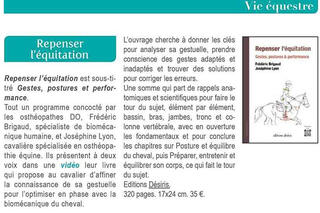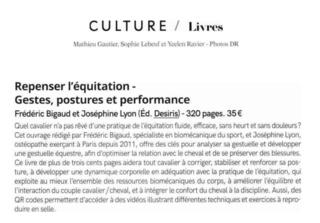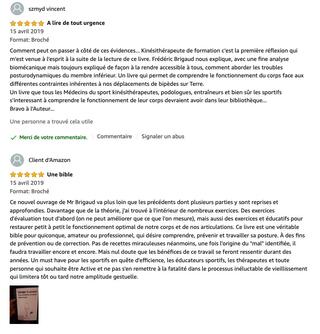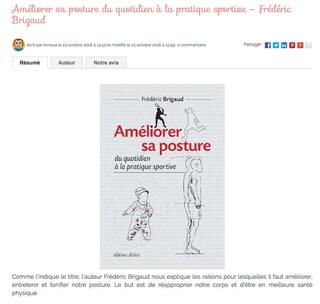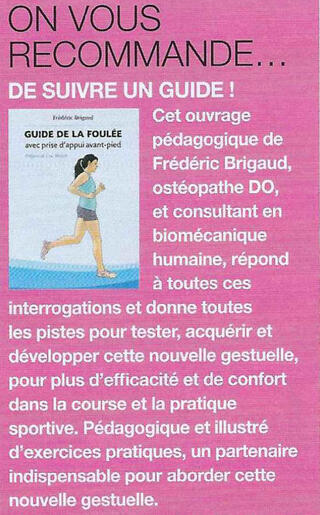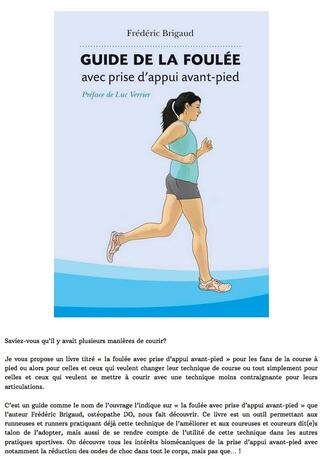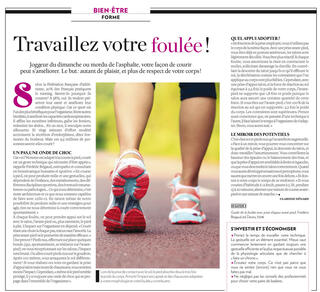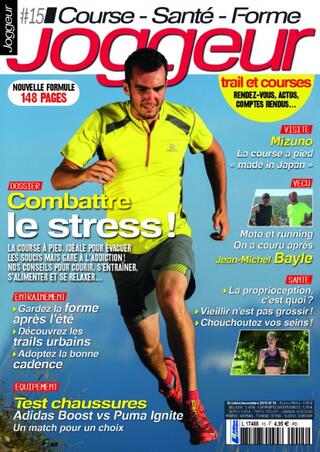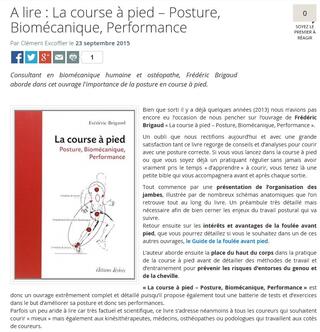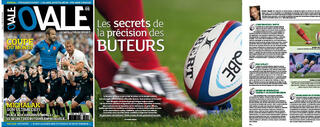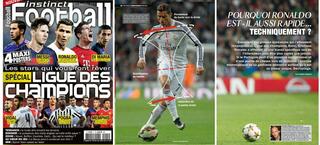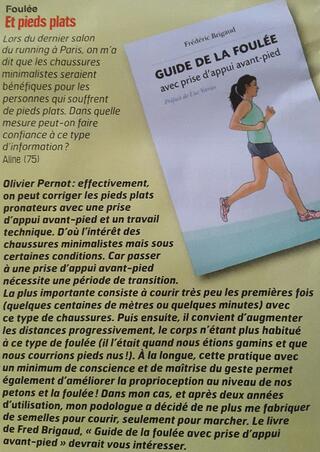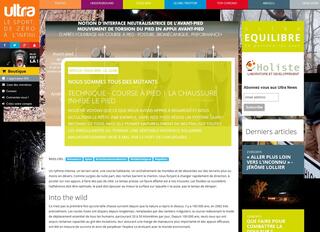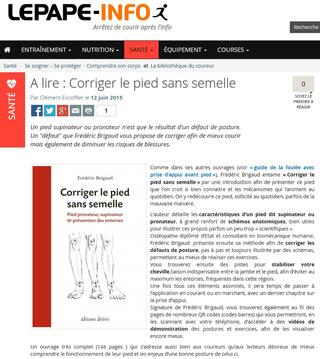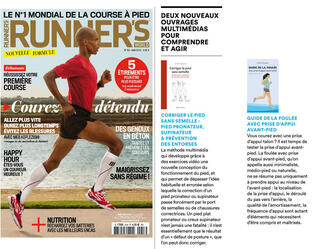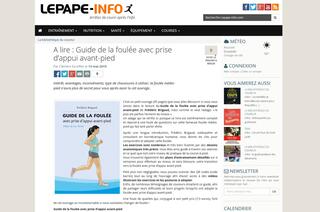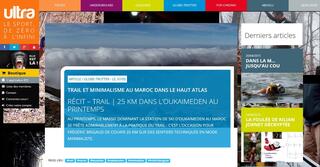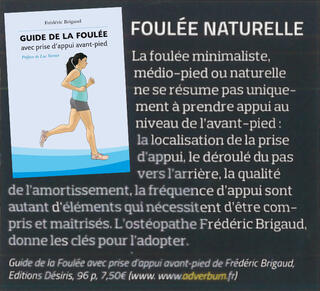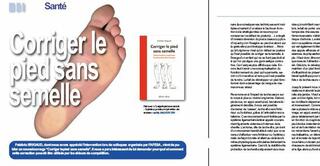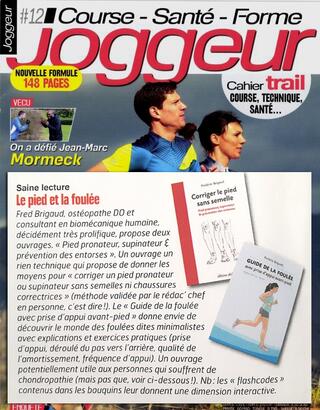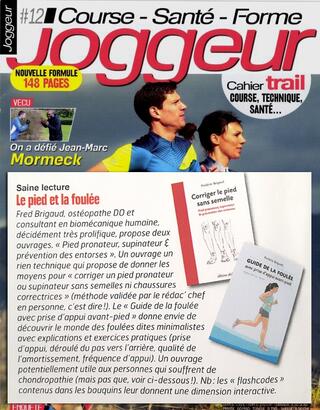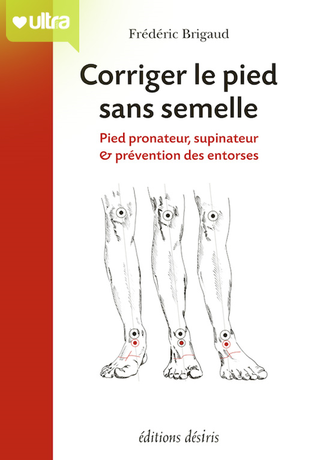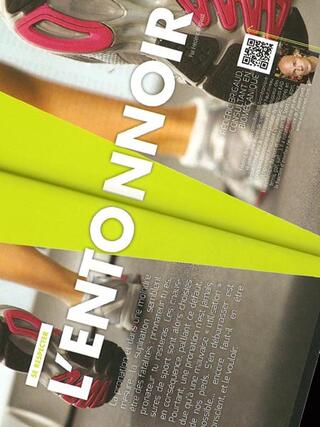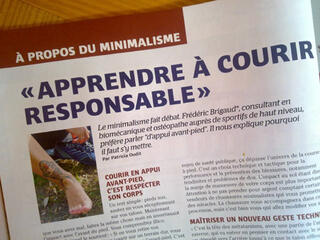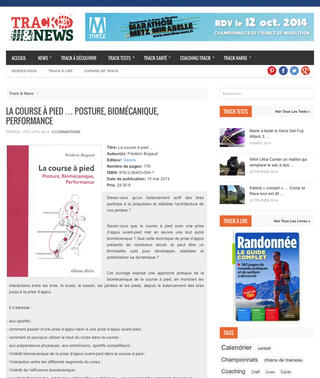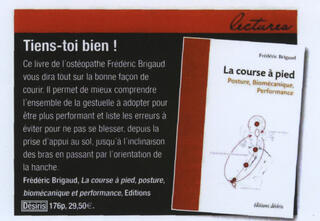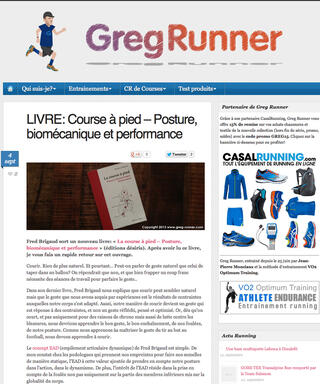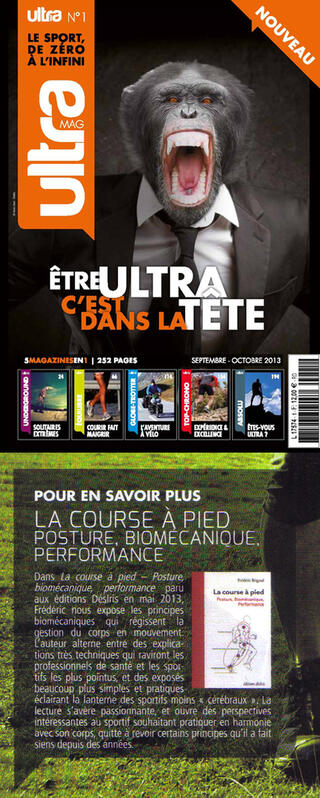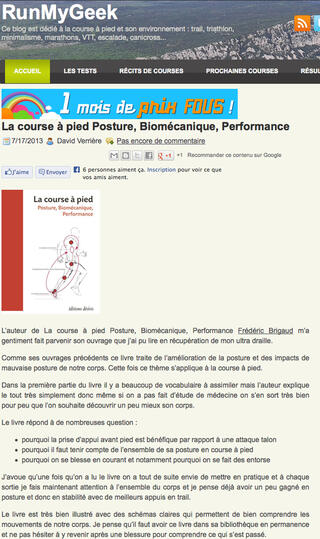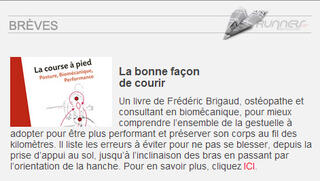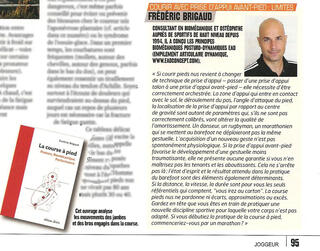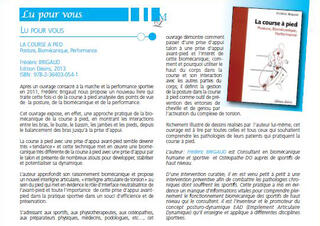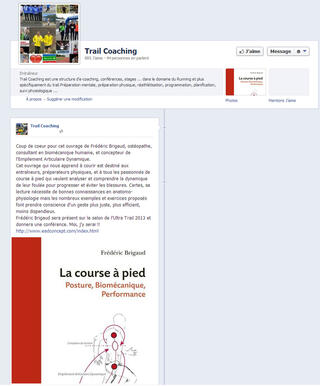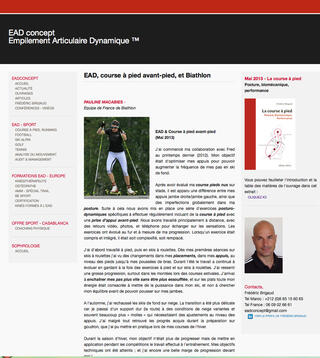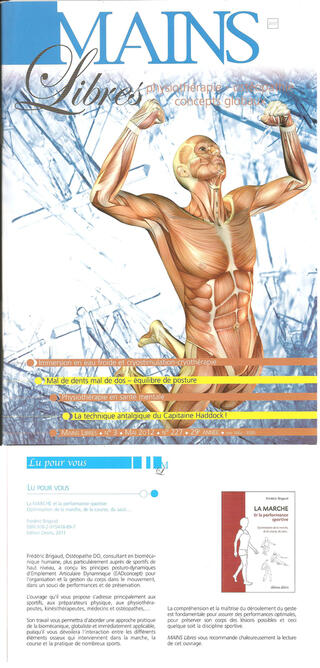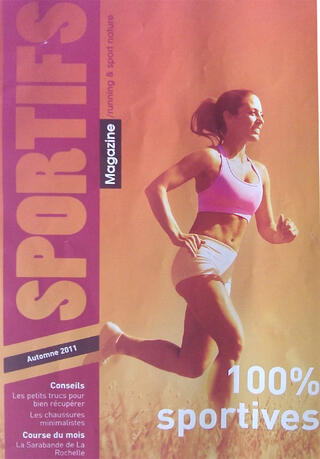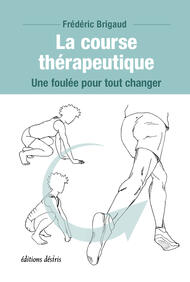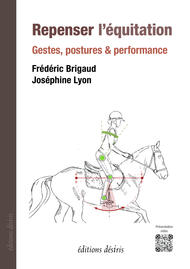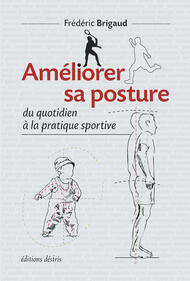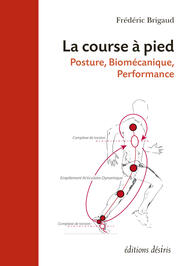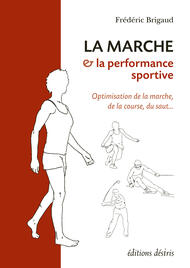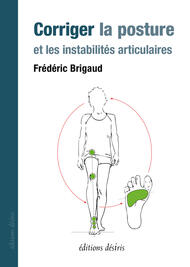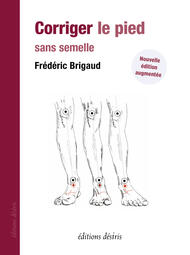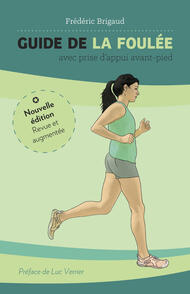Frédéric Brigaud
Consultant en biomécanique Humaine, Ostéopathe DO auprès de sportifs de haut niveau depuis 1994 :
- Consultant en biomécanique Humaine et sportive, Ostéopathe.DO de formation auprès de sportifs de haut niveau depuis 1994 : Trail, football, Ski alpin, Ski de fond, biathlon…
- Concepteur des principes posturo-dynamiques d'Empilement Articulaire Dynamique, pour l'organisation et la gestion du corps et des stratégies biomécaniques dans le mouvement, enseignés en Kinésithérapie du sport et auprès des BE Sport (Ski alpin, Tennis, Golf, Surf…)
- Consultant et formateur sport/santé pour UCPA Loisir et UCPA Formation depuis 2004
- Auteur d'articles sportifs et biomécaniques
- Auteur de :
- Repenser l'équitation, 2021, Éditions DésIris (à paraître). Ouvrage co-écrit avec Joséphine Lyon.
- Corriger le pied sans semelle - nouvelle édition, 2019, Éditions DésIris
- Corriger la posture et les instabilités articulaires, 2019, Éditions DésIris
- Guide de la foulée- nouvelle édition, 2016, Éditions DésIris
- Améliorer sa posture du quotidien à la pratique sportive, 2016, Éditions DésIris
- Gestuelle Dynamique du mouvement, 2006, Éditions Jouvence
Site : http://www.eadconcept.com
L'EAD :
L'EAD, l'éducation à une bonne gestuelle rejoint les principes pédagogiques de l'Ucpa.
Fred Brigaud intervient dans les formations Forme et Fitness de l'Ucpa, sur des apports de compétences anatomiques et sur ses travaux de l'empilement articulaire dynamique, avec des jeunes en préparation du diplôme de moniteur forme (BP JEPS AGFF) ou en formation continue avec des moniteurs diplômés, depuis cinq années.
L'Ucpa aborde les activités de forme et fitness avec une vision portée par un projet pédagogique dont une des composantes est de donner au client les clés de son autonomie. Or, l'EAD apporte, en plus d'autres éléments, des compétences complémentaires aux activités traditionnelles de forme touchant notamment la problématique de la posture, véritable base éducative à des séances de fitness et permettant de prolonger au quotidien les bonnes pratiques pour prévenir toutes les pathologies liées aux mauvaises habitudes posturales.
Le client d'une salle de fitness a tendance à consommer un produit, souvent avec une interprétation fausse d'une action en relation avec un besoin (l'exemple le plus frappant est : je désire perdre du poids et avoir une silhouette pour la plage, je fais du FAC –Fesse/abdo/cuisse-). Il a assez peu conscience d'un corps mécanique, où chaque zone est en interaction avec une autre par des relations physiques. Notre rôle éducatif est bien de faire comprendre aux clients que les contraintes que nous imposons à notre corps ont des limites et que les signaux d'alerte (la douleur) sont souvent trop tardifs.
Cette analyse anatomique du mouvement génère chez l'encadrant une réflexion globale, lui permettant de mieux aborder ses mises en place pédagogiques, ses conseils et ses exercices. À partir d'observables simples, il donne des conseils de correction aux clients. Il intègre aussi dans ses consignes et ses exercices les bases de l'EAD (repères de flexions, lignes de pied…).
L'intérêt de la méthode est qu'elle se prête à toutes les mises en place des activités de la forme et du fitness. Elle rejoint les fondamentaux des gymnastiques orientales (l'enracinement, le socle…), elle s'adapte aux répétitions des cours collectifs cardio, elle est propice aux conseils des cours de renforcement musculaire ou encore articule les mouvements sur les machines cardio ou de musculation. C'est une véritable compétence pédagogique nouvelle, à forte valeur ajoutée pour le professionnel.
Gilles Chaudesaigues, référent Ucpa vélo/forme/glisses urbaines.
Retrouvez toute l'actualité de Fred Brigaud autour de ses publications ici :
https://eadconcept.com/category/articles/
Tous les ouvrages de Frédéric Brigaud sont listés sur cette page :
https://www.adverbum.fr/ouvrages-frederic-brigaud.html
Osteopath
Worked with high-level athletes since 1994. Worked sports like Soccer, Golf, Tennis, with members of the French Ski team, Snowboard, Cross-country Ski team, ...
Creator and developer of dynamic postural principles of ‘Dynamic Joint Stacking' (Empilement Articulaire Dynamique™,EADconcept), taught in Sports Physical Therapy and in varied National Sports Diplomas (Alpine Skiing, Tennis, Golf, Surf…) since 2005.
Sport & Health consultant and trainer with sports training centers and recreation centers to develop Sport & Health camps. Multidisciplinary approach of sports biomechanics for the sake of efficiency and preservation: Soccer – Running – Tennis – Golf – Karate - Alpine Skiing - Snowboard - Cross-country Skiing -Barefoot - Running - Surf - ...
Author of books and sports articles about biomechanics
Research and development in human biomechanics and sports
at Onwer
Notions and principles of biomechanics developed
by Frédéric Brigaud © since 1994
- Principles of Dynamic Joint Stacking (Empilement Articulaire Dynamique or EAD) applied to the whole body
- Principles of organizing and managing the body while in movement
- EAD axium.
- Base of Support EAD. Pressure distribution over the base of support depending on the organization of the leg bones.
- Transverse torsion joint betwenne the fore foot and the rear foot
- Fore foot, neutralizing interface, neutralizing the slope inclination
- Presence of 2 horizontal axis inside the foot. The front foot horizontal axis and the back foot horizontal axis
- Principles of torque and torso/pelvis separation
- Quadruple muscular chains of torso/pelvis torque
- Muscular connexion between arms/torso/pelvis/leg
- Principles of joint cohesion
- Biomechanical interrelation arm/leg struggling against the collapsing of the leg and assisting propulsion
- Technique of fore foot placement associated with EAD principles
- Technique of running with a postural dynamic goal
Implementing, Teaching, Publishing and popularization of these principles
- Training these principles to National Sports Diplomas instructors since 2005
- Training these principles to the medical world since 2009
- Books presenting these varied biomechanical and postural dynamic principles 2006, 2011, 2013.
- Popularization conferences since 2002
- Implementation into sports activities for the sake of optimization and prevention
- Managing the biomechanical and postural dynamic aspect for high-level athletes (soccer, alpine skiing, Trail running, Biathlon, snowboard, karate,…) since 1994 / Optimization of the technical movement
Training of the postural dynamic principles
of ‘Dynamic Joint Stacking' (EADconcept)
2005 - Present
Taught to Physical Therapists, Osteopaths and to varied National Sports Diplomas instructors. Global biomechanical approach of the body in movement designed and developed by Frédéric BRIGAUD since the late 1990s. Originally, these biomechanical and postural dynamic principles, derived from the analysis and management of the repetitive technical athletic gesture, were designed to respond to recurring osteo-articular dysfunctions in the practice of high-level sports. Gradually, he used it to identify those at risk and undertake a postural dynamic upstream work for the sake of prevention and performance. This learning technique, rehabilitation and analysis provides the means to develop the adjustment of the
position of joints and body segments for the purposes of performance, fluidity and preservation, whatever the situations or movements.
Human biomechanics consultant and trainer
at Indépendant / UCPA - UCPA Formation
2004 - Present
For "UCPA loisir" & "UCPA Institut de formation" (french recreation centers & sports training centers). Whole Body Mechanics & Sports/Health Biomechanics Trainer. Training the postural dynamic principles of‘Dynamic Joint Stacking' (EADconcept) to different National Sports Diploma instructors (Fitness, Running, Trail Running, Hking, Alpine Skiing, …)
- Missions as a consultant
- Research of new biomechanical observable behaviors in sports conditioning, fitness, hiking, tennis, skiing
- Selection and diffusion of the technical and educational processes to be utilized and worked in different activity realm.
- Retranscription of tools and processes (Creation of handbooks)
- Management of the professional training candidates for the French National Sports Diploma.
- Training and control of the candidates in setting up and applying the Sport&Health sessions.
- Adapting existing products to the notion of Sport&Health.
- Search of new products (Sport&Health), creation and tests.
- ‘Dynamic Joint Stacking' (EAD) Training and management of French National Ski Diploma instructors since 2004.
Ski conditioning camps for the Technical Test and Eurotest candidates (90 to 120 participants). Today, it is one of the only trainings in France pushing towards self-management and empowerment of the Alpine Ski Instructing trainees.
Integration of ‘Dynamic Joint Stacking' (EAD) principles as biomechanical references for maximization and preservation of the body from the day a candidate is selected to the organization and conduct of all ski conditioning sessions... within the training institute of UCPA. A training tool. Establishing biomechanical dynamic observable behaviors instantly usable by trainers and candidates (SFP) ... Each year, all of the ski trainers and trainees are informed of those biomechanical and postural dynamic principles.
- Trail running training for hiking instructors and mountain guides
Posture, gesture and performance in jogging and trail running
Human Biomechanics Consultant for high-level athletes
1994 - Present
Postural dynamic management and follow-up.
Biomechanical efficiency and preservation
Biomechanical analysis of the athletic technical movement
- Soccer players (France, Portugal, Morocco)
- Members of the French Ski team (speed), Snowboard, Cross-country, Freestyle
- Members of the French Ski team ("B team", FFS)
- High-level athletes in Golf, Tennis, Trail… Karateka
- Sports Academies
- Sports Clubs (Soccer, Alpine Skiing, Cross-country skiing)
- ...
Published books
La course à pied - Posture, biomécanique, performance
Editions Désiris (Adverbum) / Mai 2013
La marche & la performance sportive. Optimisation de la marche, de la course, du saut…
Editions Désiris (Adverbum) / Juin 2011
Walking and Sports Performance
Understanding and controlling the course of the movement from simple walk to intensive sport, regardless of the type of moving and regardless of the sport (tennis, golf, running, trekking, karate ) are synonymous of performance and preservation. This book offers a practical approach to biomechanics by revealing the interaction between the different bone elements involved in running, walking etc It addresses itself to athletes, physical trainers, coaches, athletic competitors as well as physiotherapists, doctors and osteopaths.
Gestuelle dynamique du mouvement, Prévenir les blessures, optimiser les performances
Editions Jouvence / Mars 2006
Gestualidad dinamica del movimiento
Editorial Paidotribo / Septembre 2011
The EAD allows the adjustment of the articulations in all the plans, some is the movement and its unfolding: by the driving drain of the course of the gesture while respecting the homogeneous distribution of the pression/tension within each articular system. Its objective: optimization, safeguarding, economy and stability, respect of the physiological integrity of the articulation in its unfolding. This technique is applicable as of the mobilization of the passive and active locomotor apparatus, and in particular with very technical epicused in the sport, the trades with repetitions and each activity generating of the points of support.
Recommandation
Jean-Louis Fischer
Member of the International Academy of Science History
Centre Alexandre Koyré (CNRS-EHESS-MNHN)
To run, yes, but to run well...
After publishing his first book « Gestuelle dynamique du mouvement, Prévenir les blessures, optimiser les performances » ("Dynamic gestures in movement, prevent injuries, maximize performances" - 2006), followed by his second book « La Marche et la performance sportive » ("Walking and athletic performance" - 2011), Frédéric Brigaud, in his new book « La Course à pied » ("Running" - 2013) continues to demonstrate the legitimacy of his ‘Dynamic Joint Stacking' (EAD) concept. This concept, EAD, is the result of a deep reflection bringing into play his knowledge of the human anatomy and his meticulous observations of leg and arms movements engaged in walking, running and jumping. This relationship between the static anatomy of our body and the dynamics of our movements led Frédéric Brigaud to unveil this kinematic of our movements by creating biomechanics of the movement: for the historian, he belongs to these researchers and practitioners who hold their origin in the work, innovative at the time, of Etienne Jules Marey (1830-1904) and "La Machine animale" ("the animal machine" - 1873).
Anatomically Men are not equal says Frédéric Brigaud: "Architecturally, we are far from being equal; the shape, orientation and amplitude of the joints differ from one individual to another, as well as different component parts of the skeleton bones do." It is therefore important to know your body and learn to best use this architecture, fragile and efficient at the same time, made up of the foot, the leg, the hip, and their connection (hip, knee, ankle). This triad is built on an axis that has its logic in its positioning and functioning while walking and running. The fact of walking and running does not mean that we walk well and run well. The verticality of the Man and his permanent bipedalism do not make him a very good runner, and even if we admire the performances of the Ethiopian marathon runners in endurance running, it is that they have learned at an early age to run barefoot on a hard surface, which means running on the forefoot to avoid hitting the ground with the heel. Everything is a learning and learning at a young age when this ability to brisk walking and running is possible.
"The leg is not made of a single piece, it's a set of segments whose organization is not necessarily adapted spontaneously". Be performant, for an amateur or high-level athlete, is possible even when the adaptation to running isn't at best for the individual, but the consequences can be physically and sometimes psychologically harmful. We remember this comment from Mathieu Rached in the newspaper Le Monde on Sunday August 5th-Monday August 6th 2007 : "The training weakens the vertebrae of future champions." ‘The lesions that don't surprise nor alarm Éric Desandre Navarre, federal doctor for tennis and squash, for whom these scars found in many elite athletes, in gymnastics and platform diving in particular.' ‘The MRI studies magnify everything, he says. We cannot rely only on medical imagery which identifies signs of fracture and other bone and tendon abnormalities apart of all signs of pain.' He reminds us that it is the outbreak of ‘pain and functional impairment" that makes a stop or an intervention necessary"
If top-level athletes find themselves in this situation, it is because they didn't learn how to coordinate the right moves that would have prevented the establishment of incapacitating pathologies. Thus, doesn't the action led by Frédéric Brigaud in this learning process of the "technical and athletic gesture" deserve a very large propagation in elementary, middle and high schools? To learn how to walk, run, jump well, to practice the moves of different sports will decrease significantly the incidents on the skeleton and muscle and tendon structures. We think how the research in the biomechanics of movement developed by Frédéric Brigaud should lead the public authorities to consider this work as it is promoting the public interest and responding to the concern about hygiene and health across the Nation.
We also believe this knowledge about the biomechanics of walking and running are not without interest in the construction of prosthetics and shoe soles that replace a limb part, in the example of the carbon-fiber blades prosthetics of the athlete Oscar Pistorius or the ones that are added to the foot in order to improve its function; the shoe of a soccer player doesn't look alike the one of a runner or a tennis player. The technician in walking and running biomechanics should also have a say in the construction of these prosthetics (it could lead to superior performances to those achieved by the human body), soles and shoes. This evocation of the prosthesis technology is not without seeking our minds to this future that could be the "transformed Man" and the emergence of this new terminology, whose content is very ancient, the ‘biomimetism'. This infringement demonstrates that Frédéric Brigaud's work isn't locked in the sole goal of learning good walking and running, but it opens on issues which are those of the Man in his past, present and future.
